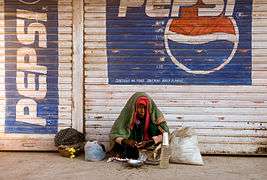Cultural geography
Cultural geography is a sub-field within human geography. Cultural geography is the study of cultural products and norms and their variations across and relations to spaces and places. It focuses on describing and analyzing the ways language, religion, economy, government and other cultural phenomena vary or remain constant, from one place to another and on explaining how humans function spatially.[1]
Areas of study

The areas of study of cultural geography are very broad. Among many applicable topics within the field of study are:
- Globalization has been theorised as an explanation for cultural convergence.[2]
- Westernization or other similar processes such as modernization, americanization, islamization and others.[3]
- Theories of cultural hegemony or cultural assimilation via cultural imperialism.
- Cultural areal differentiation, as a study of differences in way of life encompassing ideas, attitudes, languages, practices, institutions and structures of power and whole range of cultural practices in geographical areas.[4]
- Study of cultural landscapes[5][6] and cultural ecology.
- Other topics include spirit of place, colonialism, post-colonialism, internationalism, immigration, emigration and ecotourism.
History
Though the first traces of the study of different nations and cultures on Earth can be dated back to ancient geographers such as Ptolemy or Strabo, cultural geography as academic study firstly emerged as an alternative to the environmental determinist theories of the early Twentieth century, which had believed that people and societies are controlled by the environment in which they develop.[7] Rather than studying pre-determined regions based upon environmental classifications, cultural geography became interested in cultural landscapes.[7] This was led by Carl O. Sauer (called the father of cultural geography), at the University of California, Berkeley. As a result, cultural geography was long dominated by American writers.
Sauer defined the landscape as the defining unit of geographic study. He saw that cultures and societies both developed out of their landscape, but also shaped them too.[8] This interaction between the natural landscape and humans creates the cultural landscape.[8] Sauer's work was highly qualitative and descriptive and was surpassed in the 1930s by the regional geography of Richard Hartshorne, followed by the quantitative revolution. Cultural geography was generally sidelined, though writers such as David Lowenthal continued to work on the concept of landscape.
In the 1970s, the critique of positivism in geography caused geographers to look beyond the quantitative geography for its ideas. One of these re-assessed areas was also cultural geography. However, as in many geographic subdisciplines, post-positivist cultural geography continues playing an important role.
"New cultural geography"
Since the 1980s, a new cultural geography has emerged, drawing on a diverse set of theoretical traditions, including Marxist political-economic models, feminist theory, post-colonial theory, post-structuralism and psychoanalysis.
Drawing particularly from the theories of Michel Foucault and performativity in western academia, and the more diverse influences of postcolonial theory, there has been a concerted effort to deconstruct the cultural in order to make apparent the various power relations. A particular area of interest is that of identity politics and construction of identity.
Examples of areas of study include:
- Feminist geography
- Children's geographies
- Some parts of Tourism geography
- Behavioral geography
- Sexuality and space
- Some more recent developments in Political geography
- Music Geography
Some within the new cultural geography have turned their attention to critiquing some of its ideas, seeing its views on identity and space as static. It has followed the critiques of Foucault made by other 'poststructuralist' theorists such as Michel de Certeau and Gilles Deleuze. In this area, non-representational geography and population mobility research have dominated. Others have attempted to incorporate these critiques back into the new cultural geography.
Groups within the geography community have differing views on the role of culture and how to analyze it in the context of geography. It's commonly thought that geography simply dictates a culture's shelter, clothing and food choices. However, there are some who believe culture provides a way for individuals to make sense of the world around them, while others simply view culture as a means through which social change is experienced.[9] There are many ways to look at geography's role in culture, and how culture effects a group's interaction with its native geography.
Cultural Geography Journals
Academic peer reviewed journals which are primarily focused on Cultural Geography or which contain articles that contribute to the area.
- Antipode
- Area
- Cultural Geographies
- Society and Space - Environment and Planning D
- Geography Compass (Cultural Geography Section)
- Social & Cultural Geography
- Transactions of the Institute of British Geographers
Learned Societies and Groups
- Social and Cultural Geography Research Group of the Royal Geographical Society (with the Institute of British Geographers)
- Cultural Geography Specialty Group of the Association of American Geographers
- Cultural Geography Study Group of the Institute of Australian Geographers.
See also
References
- ↑ Jordan-Bychkov, Terry G.; Domosh, Mona; Rowntree, Lester (1994). The human mosaic: a thematic introduction to cultural geography. New York: HarperCollinsCollegePublishers. ISBN 978-0-06-500731-2.
- ↑ Zelinsky, Wilbur (2004). "Globalization Reconsidered: The Historical Geography of Modern Western Male Attire". Journal of Cultural Geography. 22.
- ↑ Debres, Karen (2005). "Burgers for Britain: A Cultural Geography of McDonald's UK". Journal of Cultural Geography. 22.
- ↑ Jones, Richard C.; 2006; Cultural Diversity in a “Bi-Cultural” City: Factors in the Location of Ancestry Groups in San Antonio; Journal of Cultural Geography
- ↑ Sinha, Amita; 2006; Cultural Landscape of Pavagadh: The Abode of Mother Goddess Kalika; Journal of Cultural Geography
- ↑ Kuhlken, Robert; 2002; Intensive Agricultural Landscapes of Oceania; Journal of Cultural Geography
- 1 2 Peet, Richard; 1998; Modern Geographical Thought; Blackwell
- 1 2 Sauer, Carl; 1925; The Morphology of Landscape
- ↑ Wylie, John. "Timely geographies:‘New directions in cultural geography’revisited." Area 48.3 (2016): 374-377.
Further reading
- Carter, George F. Man and the Land. A Cultural Geography. New York: Holt, Rinehart & Winston, 1964.
- Tuan, Yi-Fu. 2004. "CENTENNIAL FORUM: Cultural Geography: Glances Backward and Forward". Annals of the Association of American Geographers. 94 (4): 729-733.
